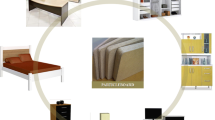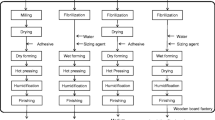Abstract
Goal, Scope and Background
Wood has many applications and it is often in competition with other materials. Chipboard is the most common item of wood-based materials and it has attained the highest economical development in recent years. Relevant up-to-date environmental data are needed to allow the environmental comparison of wood with other materials. There are several examples of Life Cycle Assessment (LCA) evaluations of some wood products and forest-technology systems, but no comprehensive Life Cycle Inventory (LCI) data for particleboard manufacture is available in the literature. The main focus of this study is to generate a comprehensive LCI database for the manufacture of resin-bonded wood particleboards.
Methods
In this work, International Organization for Standardization (ISO) standards and Ecoindicator 99 methodology were considered to quantify the potential environmental impact associated to the system under study. A Spanish factory considered representative of the 'state of art' was studied in detail. The system boundaries included all the activities taking place inside the factory as well as the activities associated with the production of the main chemicals used in the process, energy inputs and transport. All the data related to the inputs and outputs of the process were obtained by on-site measurements.
Results and Discussion
LCI methodology was used for the quantification of the impacts of the particleboard manufacture. The inventory data of the three defined subsystems are described: - Wood preparation: a comprehensive inventory of data including storage, debarking, particle production, storage and measurement of particles, drying and combustion of the bark for energy purposes. - Board shaping: data related to particle classification, resin mixing, mattress formation and the pressing stage. - Board finishing: cooling data, finishing, storage and distribution of the final product. The system was characterised with Ecoindicator 99 methodology (hierarchic version) in order to identify the 'hot spots'. Damage to Human Health was mainly produced by the subsystem of Board finishing. The subsystem of Board shaping was the most significant contributor to damage to the Ecosystem Quality and Resources.
Conclusions
With the final aim of creating a database to identify and characterise the manufacture of particleboard, special attention was paid to the inventory analysis stage of the particleboard industry. A multicriteria approach was applied in order to define the most adequate use of wood wastes. Environmental, economic and social considerations strengthen the hypothesis that the use of forest residues in particleboard manufacture is more sustainable than their use as fuel.
Recommendations and Outlook
In this work, particleboard was the product analysed, as it is one of the most common wood-based materials. Future work will focus on the study of another key wood board: Medium Density Fibreboard (MDF). Moreover, factors with strong geographical dependence, such as the electricity profile and final transport of the product, will be analysed. In addition, the definition of widespread functional unit to study the use of wood wastes at the end-of-life stage may be another issue of outstanding interest.
Similar content being viewed by others
Author information
Authors and Affiliations
Corresponding authors
Rights and permissions
About this article
Cite this article
Rivela, B., Hospido, A., Moreira, T. et al. Life Cycle Inventory of Particleboard: A Case Study in the Wood Sector (8 pp). Int J Life Cycle Assessment 11, 106–113 (2006). https://doi.org/10.1065/lca2005.05.206
Received:
Accepted:
Published:
Issue Date:
DOI: https://doi.org/10.1065/lca2005.05.206




